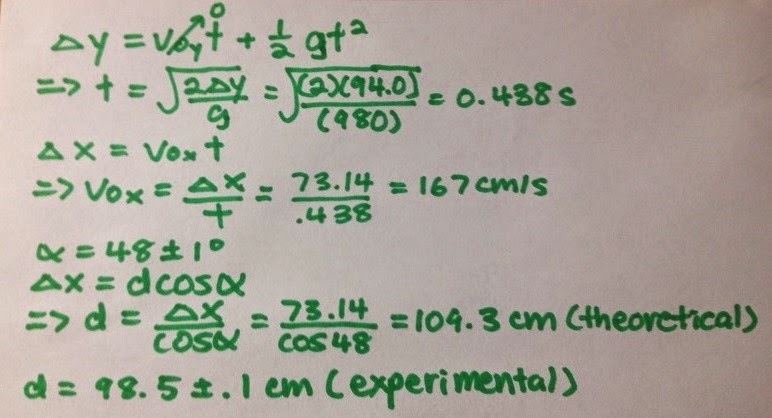The purpose of this experiment was to analyze three different collisions to see if the impulse-momentum principle holds true.
PROCEDURES
Part 1
 |
| Figure 1 |
We began by setting up the experiment as illustrated in Figure 1 (click to enlarge). As it can be observed from the image, a force sensor was fixed to a cart moving on a track. The hook on the force sensor that actually did the measuring of forces was removed and replaced by a rubber stopper (labeled in red in Figure 1). The purpose of this rubber stopper was to enable the cart to have a direct collision with the red cart at the location marked in green in Figure 1. In addition, a motion sensor was placed at one end of the track as shown in Figure 1 with a blue circle.
 |
| Figure 2 |
After constructing our set-up, we proceeded to give the cart with the force sensor a push toward the stationary cart. We captured the motion of the moving cart with the motion sensor and plotted two graphs on Logger Pro. One was velocity with respect to time and the other was force with respect to time (Figure 2). We used the "Examine" function on the velocity versus time graph to find the velocity of the cart before and after the collision. We assumed that the curved portion of the graph corresponded to the change in velocity during the collision. Therefore, we took the linear parts to be the initial and final velocities. We then applied the "Integral" function on the force versus time graph as shown in Figure 2. The area under this graph was supposed to represent the impulse of the collision.
 |
| Figure 3 |
After analyzing the graphs, we used the values that we found to compare the change in momentum to the impulse of collision. We found the change in momentum by using the initial and final velocities as shown in Figure 3. The resulting value was 0.585 N*s. Referring back to Figure 2, it can be seen that the impulse was 0.5443 N*s. In order to compare these values, we found the percent error, which was 6.97 percent. Therefore, it can be seen that the impulse-momentum theorem holds.
Part 2
 |
| Figure 4 |
For the next part of the experiment, we added 200 g to the moving cart and once again pushed it toward the stationary cart to cause a collision between the two objects. We repeated the same process as the first part of the experiment and plotted velocity and force with respect to time. These graphs are shown in Figure 4. Just as before, we applied the "Examine" tool on the velocity versus time graph to find the initial and final velocities, which we found to be -0.477 m/s and 0.426 m/s, respectively. In addition, we took the integral of the force versus time graph to find the impulse. As it can be seen from the image, the resulting value was 0.6998 N*s.
 |
| Figure 5 |
As we did in the first part of the experiment, we found the change in the momentum from the initial and final velocities. We found this value to be 0.759 N*s. We compared this value to the impulse found from the force versus time graph by calculating the percent error. We found this to be 7.80 percent, which was a similar result to the first part of the experiment. We can conclude from this result that the impulse-momentum theorem held true in this collision.
Part 3
 |
| Figure 6 |
For the final part of the experiment, we replaced the red cart with clay attached to a wooden stand. We also taped a nail to the end of the rubber stopper. This was done to simulate an inelastic collision. We once again plotted two graphs to find the final and initial velocities of the cart and the impulse of the collision. These graphs are shown in Figure 7 below. After examining the graphs, we noticed that there were some oscillations at the end of the force versus time graph. These oscillations can most likely be attributed to the cart stabilizing as it was coming to a stop.
 |
| Figure 7 |
 |
| Figure 8 |
From the velocity versus time graph, we found the initial velocity to be -0.424 m/s and the final velocity to be zero (which we could have figured out on our own). From these values, we found the change in momentum to be 0.357 N*s. Next, we found the impulse to be 0.3869 N*s by integrating the force versus time graph. The percent error between these values is 7.73 percent, which is an acceptable number. As a result, we can conclude that the impulse-momentum principle holds true for this part of this experiment.
CONCLUSION
We learned from this process that the impulse-momentum principle actually holds true in a real-life situation. This was a valuable experience because we witnessed firsthand that what we learn in the classroom can be tested in an experiment. Furthermore, having practice of these theorems in an experiment, helps us fully understand what these concepts mean.
Like any experiment, there were several factors that could have contributed to error in the values that we found. For example, we assumed in the first two parts that the collisions were elastic. However, they were most likely not completely elastic. Another source of error could have been from the force sensor. Since there was a rubber stopper attached to it, there is a possibility that the force sensor did not properly register the forces being exerted on the cart. This is most likely the reason why the impulses were smaller than the changes in momentum.











.png)

.png)





















